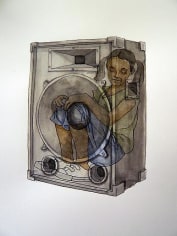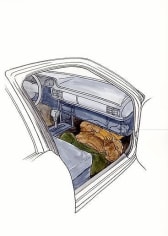Displaced
November 1 – December 15, 2007
John Berggruen Gallery is proud to present Displaced, an exhibition of new works on paper that engage forms of displacement. The exhibition will feature recent works by artists Jonathan Callan, Frank Ebert, Armando Miguelez, Julio Cesar Morales, and Gabrielle Teschner. Displaced opens Thursday November 1st and will run through December 15, 2007. John Berggruen Gallery will host a reception for the artists on Thursday, November 1st from 5:30 to 7:30pm.
While many artists create works on paper, few actually make the physicality of paper a central subject in their work. Jonathan Callan is such an artist, as he not only makes works on paper, but also explores the physical limitations of the material. Callan is known for his range of innovative techniques for transforming paper into a powerful sculptural medium. His applications range from slicing and chipping, to extruding silicone through paper. In Callan's work, displacement plays a multiplicity of roles. In his two dimensional work his subjects are often compositionally displaced in the picture plane, but rather than adding forms onto the page, Callan removes the content around his subjects by sanding the image away like a fading memory. Callan has been included in a number of exhibitions in North America and Europe including a solo exhibition at the Mattress Factory in Pittsburg in 2005.
Frank Ebert is a recent graduate from the California College of the Arts where he received his MFA in painting and drawing. Ebert's work stems from a photorealist tradition in which he renders figures from popular magazines such as Guitar Player or Vogue into highly detailed drawings of forms compositionally scattered around the picture plane. For Ebert, the displacement of the figure in the drawing is not only a compositional concern, but also a means to describe the psychological disjunction between the reality and the dreams the figures may have for each other in the picture. Ebert has exhibited internationally in places such as Japan and Mexico as well as in the Bay Area and the Midwest.
One of the continuing discourses surrounding contemporary cartography is how the displacement of people and culture constantly affects our view of the world. This discourse, coupled with what scholars are considering a technological development in cartography unparalleled since the Renaissance, has resulted in many contemporary artists turning to cartographic techniques to illustrate pressing issues of globalization in culture. One such artist is Armando Miguelez, who has created a body of work based on maps of major cities around the globe. These drawings are dualistic tracings: that of the map itself and of Miguelez' own global displacement. Each map is a tracing of the human mark left by urbanization, and each is inscribed with the location and date where Miguelez has made them. In effect, a singular work may be made in transit between multiple locations ranging from Buenos Aires to Beijing. His most recent drawings have focused on the bisected urban border structure of Juarez, Mexico, and El Paso, Texas, which he has executed while traveling between Mexico City and Marfa, Texas. Miguelez has exhibited extensively throughout Europe, North and South America.
In the United States, one of the most socially pressing topics of contemporary displacement is the movement of illegal immigrants across the Mexican-American border. For Julio Cesar Morales, an artist born in Tijuana and currently based out of San Francisco, these illegal crossings have served as a complex muse for his illustrative practice. Morales has created a series of watercolors which are based on documentary photographs taken by the U.S. Border Patrol. These photographs depict illegal immigrants caught in some of the most desperate attempts - a child in a pinata, or a man sewn into a car seat - to cross the American border. In Morales' work, watercolor is employed to soften the harsh realities of these documentary images as a means to make them more visually accessible to the viewer. Morales' watercolors have been included in the permanent collection of the Museum of Contemporary Art in San Diego. Additionally, his work has been displayed widely in the Bay area, and in numerous international exhibitions including the 2004 San Juan Triennial, the 2006 Singapore Biennial, and he is currently representing Mexico in the 2007 Istanbul Biennial.
Gabrielle Teschner is another recent graduate from CCA's MFA program in studio arts. For Displaced, the gallery will exhibit several works from her map series. In these works made of vintage maps, Teschner stencils and cuts out phrases such as "Standard Parallels" and "Here lies" that are common to the cartographic vernacular. In works like Here Lies Japan, a work made out of a map of Europe, the technique of simultaneously adding text while physically removing it, coupled with the phrase itself, suggests the permeability of cultural borders in the age of globalization. Teschner has exhibited throughout the Bay Area, and was the recipient of the 2007 Barclay Simpson Award.

































